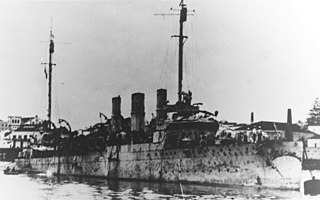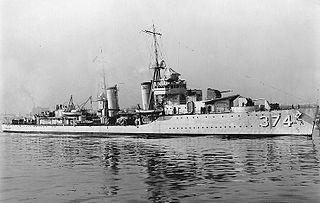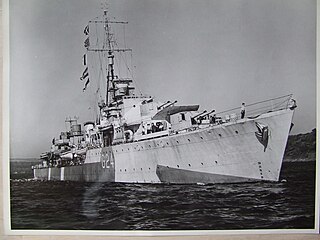
USS New York (BB-34) was a United States Navy battleship, the lead ship of her class. Named for New York State, she was designed as the first ship to carry the 14-inch (356 mm)/45-caliber gun.

Mahan-class destroyers of the United States Navy were a series of 18 destroyers of which the first 16 were laid down in 1934. The last two of the 18, Dunlap and Fanning, are sometimes considered a separate ship class. All 18 were commissioned in 1936 and 1937. Mahan was the lead ship, named for Rear Admiral Alfred Thayer Mahan, an influential historian and theorist on sea power.

The Fletcher class was a class of destroyers built by the United States during World War II. The class was designed in 1939, as a result of dissatisfaction with the earlier destroyer leader types of the Porter and Somers classes. Some went on to serve during the Korean War and into the Vietnam War.

The Benham class of ten destroyers was built for the United States Navy (USN). They were part of a series of USN destroyers limited to 1,500 tons standard displacement by the London Naval Treaty and built in the 1930s. The class was laid down in 1936-1937 and all were commissioned in 1939. Much of their design was based on the immediately preceding Gridley and Bagley-class destroyers. Like these classes, the Benhams were notable for including sixteen 21-inch (533 mm) torpedo tubes, the heaviest torpedo armament ever on US destroyers. They introduced a new high-pressure boiler that saved space and weight, as only three of the new boilers were required compared to four of the older designs. The class served extensively in World War II in the Atlantic, Mediterranean, and Pacific theaters, including Neutrality Patrols in the Atlantic 1940-1941. Sterett received the United States Presidential Unit Citation for the Battle of Guadalcanal and the Battle of Vella Gulf, and the Philippine Republic Presidential Unit Citation for her World War II service. Two of the class were lost during World War II, three were scrapped in 1947, while the remaining five ships were scuttled after being contaminated from the Operation Crossroads atomic bomb tests at Bikini Atoll in the Pacific.

The first USS Chauncey was a Bainbridge-class destroyer, also referred to as a "Torpedo-boat destroyer", in the United States Navy named for Commodore Isaac Chauncey. She was launched in 1901 and sunk in 1917.
USS Allen (DD-66) was a Sampson-class destroyer of the United States Navy launched in 1916. She was the second Navy ship named for Lieutenant William Henry Allen (1784–1813), a naval officer during the War of 1812. She was the longest-serving destroyer on the Naval Vessel Register when she was sold in 1946 and was one of the few ships in the US Navy during World War II which was completed during World War I.

The Clemson class was a series of 156 destroyers which served with the United States Navy from after World War I through World War II.

USS Badger (DD–126) was a United States Navy Wickes-class destroyer in commission from 1919 to 1922 and from 1930 to 1945. She saw service during World War II. She was named for Commodore Oscar C. Badger.

The second USS Blakeley (DD–150) was a Wickes-class destroyer in the United States Navy, named for Captain Johnston Blakeley.

USS Milwaukee (CL-5) was an Omaha-class light cruiser built for the United States Navy during the 1920s. The ship spent most of her early career assigned to the Asiatic and Battle Fleets. In 1941, she was assigned to the Neutrality Patrol until she was refitted in New York in late 1941. She escorted a troop convoy to the Pacific in early 1942 before returning to the South Atlantic where she patrolled for German commerce raiders and blockade runners. In November, she intercepted one of the latter, but it scuttled itself before it could be captured. In 1944, she was temporarily transferred to the Soviet Navy and commissioned as Murmansk. The ship was returned by the Soviets in 1949 and sold for scrap in December.

USS Conner (DD-72), a Caldwell-class destroyer, served in the United States Navy, and later in the Royal Navy as HMS Leeds.

USS Satterlee (DD-190) was a Clemson-class destroyer in the United States Navy, entering service in 1919. After brief service until 1922, the ship was placed in reserve. The ship was reactivated for World War II before being transferred to the Royal Navy in 1940. Renamed HMS Belmont, the destroyer was used as a convoy escort in the Battle of the Atlantic where she was torpedoed and sunk on 31 January 1942.

The first USS McCook (DD-252) was a Clemson-class destroyer in the United States Navy. Entering service in 1919, the ship had a brief active life before being placed in the reserve fleet. Reactivated for World War II, the ship was transferred to the Royal Navy and then to the Royal Canadian Navy and renamed HMCS St. Croix. Assigned as a convoy escort in the Battle of the Atlantic, St. Croix was torpedoed and sunk on 20 September 1943.

The first USS McLanahan (DD-264) was a Clemson-class destroyer in the United States Navy and transferred to the Royal Navy where she served as HMS Bradford (H72) during World War II.

The Caldwell class was a class of six "flush deck" United States Navy destroyers built during World War I and shortly after. Four served as convoy escorts in the Atlantic; the other two were completed too late for wartime service. Two were scrapped during the 1930s, but four survived to serve throughout World War II, three of these in service with the Royal Navy under the Destroyers for Bases Agreement and the fourth as a high speed transport.

The Gridley-class destroyers, named for Charles Vernon Gridley, were a class of four 1500-ton destroyers in the United States Navy. They were part of a series of USN destroyers limited to 1,500 tons standard displacement by the London Naval Treaty and built in the 1930s. The first two ships were laid down on 3 June 1935 and commissioned in 1937. The second two were laid down in March 1936 and commissioned in 1938. Based on the preceding Mahan-class destroyers with somewhat different machinery, they had the same hull but had only a single stack and mounted sixteen 21 inch (533 mm) torpedo tubes, an increase of four. To compensate for the increased torpedo armament weight, the gun armament was slightly reduced from five 5"/38 caliber guns (127 mm) to four. USS Maury (DD-401) made the highest trial speed ever recorded for a United States Navy destroyer, 42.8 knots. All four ships served extensively in World War II, notably in the Solomon Islands and the Battle of the Philippine Sea, with Maury receiving a Presidential Unit Citation.

USS Tucker (DD-374) was one of 18 Mahan-class destroyers built for the United States Navy and was commissioned in 1936. Tucker's main battery consisted of five dual-purpose 38 caliber 5-inch guns.

HMCS Huron was a Tribal-class destroyer that served in the Royal Canadian Navy in the Second World War and the Korean War. She was the first ship to bear this name, entering service in 1943. She was named for the Huron people. During the Second World War the vessel saw service in Operation Neptune in the Bay of Biscay and along the French coast in support of the invasion of Normandy and escorted convoys to the Soviet Union. Following the war, the ship was placed in reserve. The destroyer was activated in 1950 as a training ship, but with the onset of the Korean War, was modernized and deployed twice to Korea. Following the war, Huron reverted to a training ship and took part in Cold War-era North Atlantic Treaty Organization (NATO) naval exercises until being paid off for the final time in 1963 and broken up for scrap in 1965.

HMS Termagant was a T-class destroyer of the Royal Navy that saw service during the Second World War. She was built by William Denny and Brothers, of Dumbarton and launched on 22 March 1943. She was scrapped in 1965.

HMS Serapis was an S-class destroyer of the British Royal Navy. The ship was built by Scotts Shipbuilding and Engineering Company from 1941 to 1943, and was launched on 25 March 1943 and completed on 25 December 1943.




















